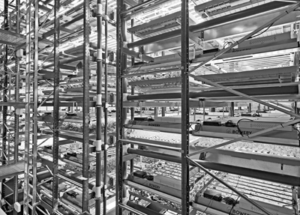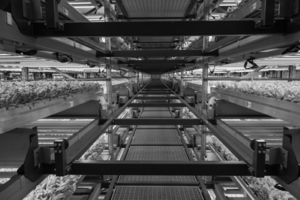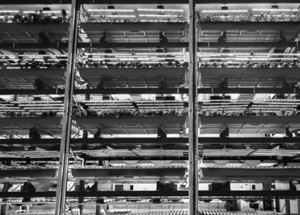Editorial
Vertical Farming and Reaching For a Better Future
by A.T. Greenblatt

There’s something truly special when you walk into a grow room of a vertical farm. If you stand in the center of it, one flight up and a half a dozen rows in, you are completely surrounded by green and growing things; above and below, stretching out on either side. There’s the smell of young plants and the beeping of crop trays being moved in and out of their positions, tracing their path along the tracks, traveling closer or farther away, sometimes in the row next to you or a level up.
It is very science fictional.
For those who might not be familiar with vertical farming, the idea is that instead of growing crops in a field or a greenhouse, food is grown indoors and in layers, with each level having its own lights, water supply, and air flow, thus growing crops on smaller footprints of land. So much so that this particular farm is a hundred times more productive than traditional agriculture. It also requires 95 percent less water because crops are grown hydroponically and the water in the system can be reused and recirculated. It can be set up anywhere, such as unused warehouses, shipping containers, and old tunnels https://www.agritecture.com/blog/2019/12/16/abandoned-tunnel-in-south-korea-converted-into-vertical-farm.
This technology is climate change driven. As Earth’s population grows, so do the demands on the food chain, requiring more land to be cleared for fields and more water to be used. It should come as no surprise that communities in desert and drought prone areas are particularly interested in vertical farms. Or that NASA initially pioneered https://www.nasa.gov/technology/tech-transfer-spinoffs/nasa-research-launches-a-new-generation-of-indoor-farming/ this emerging industry and is actively conducting research to advance space agriculture https://www.cnbc.com/2021/06/20/space-agencies-are-learning-how-to-farm-on-mars-and-the-moon.html. After all, what is more resource and real estate strapped than a vessel traveling through space for months or years at a time?

As of right now, the industry is still in its infancy. The company I work for, Bowery Farming, currently grows leafy greens at a production scale (lettuces, kale, herbs, spinach, bok choy), partially because there’s a market for it and partially because they’re some of the most forgiving crops to grow in a vertical farm. Plants have spent millions of years evolving to survive and thrive outdoors under certain conditions, and it is amazing how complicated it is to recreate that growing experience indoors on a massive scale. Plants in a vertical farm can grow more consistently due to the artificially long and unvarying daylight hours, but certain crops, like spinach, which are susceptible to water borne diseases, are a challenge to grow in this system. Bowery’s farms are pesticide free, which means the agriculture science and operation team are constantly monitoring for contamination, and the engineering team has designed a comprehensive cleaning method of all the piping, tanks, and pumps that is done routinely.
I am not a grower, which is a phrase everyone in agriculture seems to use when they are not a lead farmer or expert on a particular crop. But in my case, it’s painfully true. My job as an engineer for Bowery is to help design new farms and to modify or create new systems in existing ones. For example, during the first half of 2023, I spent countless hours on the floor of the grow room, below all the racking and the crops, while trying to figure out how to cultivate spinach at a production scale. This is where my teammates and I built our first prototype systems, obsessed over water flow, nutrient balance, leaf color, and root health for months. It’s amazing how normal it became to shout instructions to people above or below me, how many meetings my teammates and I took from the bottom of the grow room because we were in the middle of something and lost track of time. I’ve been accidentally soaked on dozens of occasions, and still laugh about that time a coworker and I had a whole Zoom call where we only communicated by hand signals because I forgot headphones and the irrigation room was too loud.

Even after months of working with spinach, I’m still learning things, and am still surprised by experimental results. In a vertical farm, every new crop is like a puzzle that has dozens of factors to consider, growing conditions to try, and individual plant preferences to take into account. It requires an amazing amount of teamwork, resourcefulness, and innovation. Before working for Bowery, I didn’t appreciate it, but food, it turns out, is really complicated to grow.
People often ask if vertical farming is going to replace traditional agriculture in the future, and the answer is no. There’s still so much to learn about how to grow a wider variety of crops in this space and how to ensure that the infrastructure the farm needs can withstand climatic events that are becoming more and more frequent. Vertical farming will most likely be used in tandem with other forms of agriculture, such as regenerative farming, which is a practice that helps protect and restore biodiversity to farmlands. It will be critical for areas with water shortages or large populations, but could have more limited implications for areas that don’t have the infrastructure to support it or maintain it.
Vertical farming is still a developing technology that has the power to create diversity and agility in a food chain that’s frighteningly fragile, under increasing strain from population growth, and facing ongoing threats from climate change. It’s not a perfect solution, but, like good science fiction, it helps us imagine, problem solve, and reach for a better future.
A.T. Greenblatt is a Nebula-Award-winning SF author and a mechanical engineer. Her fiction has been published in Asimov’s, Clarkesworld, and other venues.
Copyright © 2024 A.T. Greenblatt
